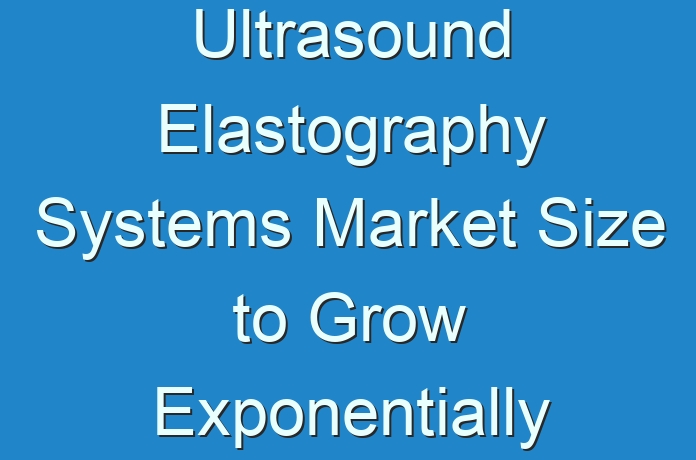
Elastography-based imaging technique is a novel technology that works on the principle of alterations in tissue mechanical properties. Elastography technique is gaining momentum in recent years as it non-invasively assesses the change in elasticity of tissues which is detected and imaged. In various pathologies of the tissue, elastography yields qualitative and quantitative information in response to an applied mechanical force which is used for diagnostic purposes.
Request Brochure for Report – https://www.transparencymarketresearch.com/sample/sample.php?flag=B&rep_id=39362
Elasticity imaging using ultrasound provides additional information over the conventional ultrasound such as stiffness of tissue. Elastography is a promising technology to identify tissue stiffness that causes changes in the mechanical properties of tissues and do not get imaged by the customary medical imaging devices such as computed tomography (CT), traditional ultrasound (US), and magnetic resonance imaging (MRI). The global ultrasound elastography market is anticipated to be driven by wider availability, convenience, non-invasive nature, and relatively low cost. Ultrasound elastography has similar technical limitations as traditional sonography which are related to the reproducibility of the measurements. In ultrasound elastography, tissue attenuation decreases ultrasound signal as a function of depth, thereby affecting the accurate assessment of deeper tissue or organs. Fluids and subcutaneous fat also reduce the propagation of the external stimulus applied at the skin surface which can deliver misguiding measurements. Challenges such as overcoming biased results, lack of reimbursement, and having an edge over other imaging modalities such as MRI could act as restraints of the global ultrasound elastography market during the forecast period.
Request for Analysis of COVID19 Impact on Ultrasound Elastography Systems Market –
https://www.transparencymarketresearch.com/sample/sample.php?flag=covid19&rep_id=39362
The global ultrasound elastography systems market can be segmented based on technique, application, end-user, and region. In terms of technique, the market can be categorized into static elastography (SE), dynamic elastography with harmonic stimuli (DEHS), and dynamic elastography with transient stimuli (DETS). DEHS is sub-segmented into sonoelastography, shear wave-induced resonance elastography (SWIRE), vibro-acoustography (VA), harmonic motion imaging (HMI), and shear wave dispersion ultrasound vibrometry (SDUV). The DETS segment can be further classified into five types: transient elastography (TE), shear wave elasticity imaging (SWEI), supersonic shear imaging (SSI), comb-push ultrasound shear elastography (CUSE) and guided wave elastography (GWE). SE methods only allow semi-quantitative assessments of stiffness. Measurements from methods that utilize external stimuli, such as SE, are the most challenging to reproduce, as the magnitude of the applied stress is difficult to control. The shear wave technique is more easily reproducible than strain or compression elastography and is soon expected to become a part of regular ultrasound exam. Although ultrasound systems providing SE have been commercially available longer than shear wave, the shear wave ultrasound elastography is expected to gain traction as the preferred technique during the forecast period. Ultrasound elastography has applications in the imaging of liver disease, breast lesion, prostate cancer, thyroid, kidney, lymph node, and others. It is useful in guiding biopsy in liver related disorders. Cancerous lesions in the breast are quite hard and ultrasound elastography is less significant in evaluating breast lesions or breast screening as compared with other diagnostic imaging techniques. Based on end-user, the global ultrasound elastography market can be segmented into hospitals, diagnostic imaging centers, and radiology centers.
Pre book Market Report –
https://www.transparencymarketresearch.com/checkout.php?rep_id=39362<ype=S
In terms of region, the global ultrasound elastography systems market can be segmented into North America, Europe, Asia Pacific, Latin America, and Middle East & Africa. North America, Europe, and Asia Pacific together are expected to dominate the global market during the forecast period, capturing more than half the share of the global market. According to the U.S. Centers for Disease Control, the U.S. had around 1.4 million people with chronic HBV infection in 2014. Additionally, Asian and Pacific Islanders in the U.S. account for more than 50% Americans living with chronic HBV infection. The prevalence of nonalcoholic fatty liver disease (NAFLD) (directly linked to being overweight or obese and having diabetes and dyslipidemia) is estimated at 27% to 34% in the U.S. and 20% to 30% in Europe which is higher as compared to the prevalence in other countries in the world. Rise in prevalence of cancer and urological disorders, increase in R&D investments by the leading companies, and ongoing research studies are factors anticipated to propel the ultrasound elastography systems market in these regions from 2017 to 2025.
Ask for Discount:
https://www.transparencymarketresearch.com/sample/sample.php?flag=D&rep_id=39362
Companies operating in the global ultrasound elastography systems market include Supersonic Imagine, Siemens Healthineers, Toshiba America Medical Systems Corporation, GE Healthcare, BK Ultrasound, Koninklijke Philips N.V., Hitachi Medical Systems, Esaote SpA, SAMSUNG, ECHOSENS, CHISON, SIUI, Shenzhen Mindray Bio-Medical Electronics Co., Ltd., SonoScape Medical Corp., and Shenzhen Landwind Industry Co., Ltd. to name few. The key players are anticipated to focus on widening the clinical applications of ultrasound elastography through 2025.
Browse More Reports by Transparency Market Research:
Cardiac Biomarker Diagnostic Kits Market:
Mechanical Ventilators Market:
Hypopigmentation Disorder Treatment Market:
About Us
Transparency Market Research is a global market intelligence company providing global business information reports and services. Our exclusive blend of quantitative forecasting and trends analysis provides forward-looking insight for several decision makers. Our experienced team of analysts, researchers, and consultants use proprietary data sources and various tools and techniques to gather and analyze information.
Our data repository is continuously updated and revised by a team of research experts so that it always reflects latest trends and information. With a broad research and analysis capability, Transparency Market Research employs rigorous primary and secondary research techniques in developing distinctive data sets and research material for business reports.
Contact
Transparency Market Research,
90 State Street, Suite 700,
Albany, NY 12207
Tel: +1-518-618-1030
USA – Canada Toll Free: 866-552-3453





